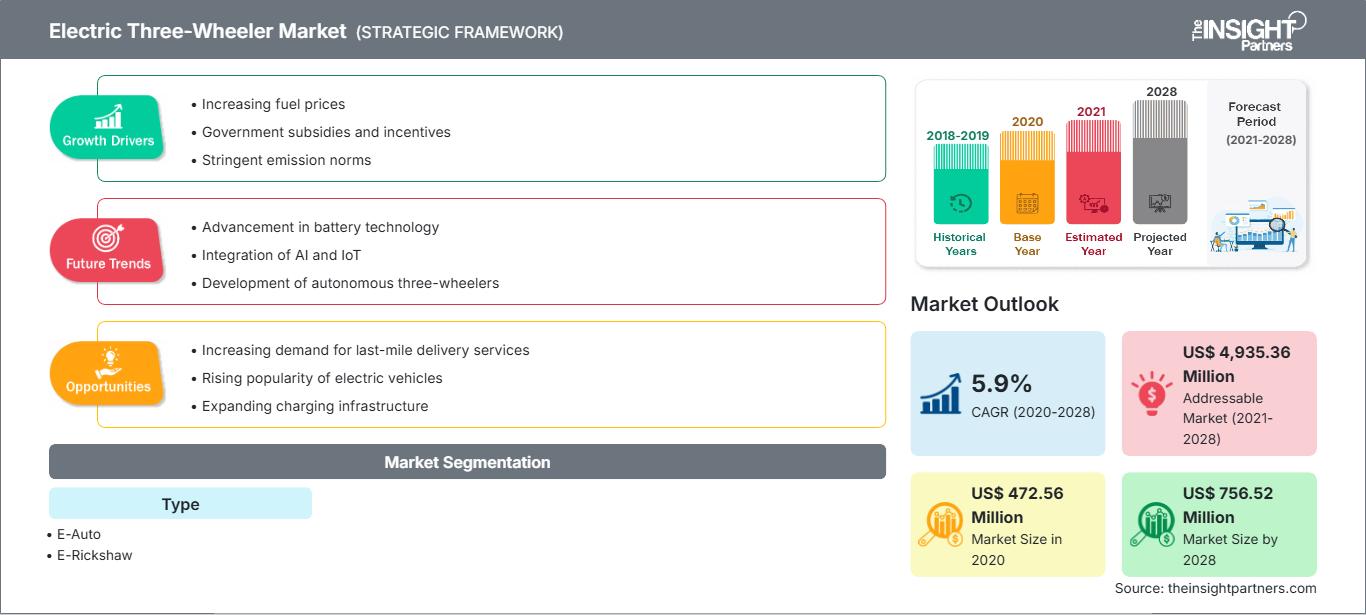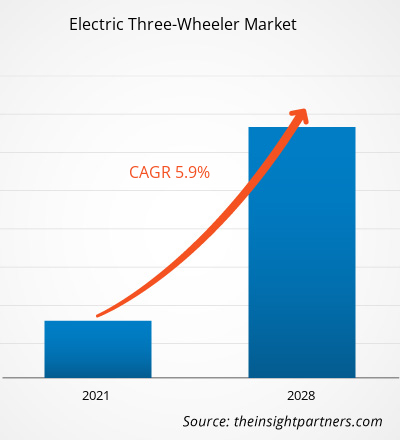El mercado de vehículos eléctricos de tres ruedas se valoró en US$ 472,56 millones en 2020 y se proyecta que alcance los US$ 756,52 millones en 2028; se espera que crezca a una CAGR del 5,9% entre 2021 y 2028.
Los vehículos eléctricos de tres ruedas se utilizan ampliamente para el transporte de pasajeros y mercancías. Estos vehículos funcionan con motores eléctricos alimentados por baterías recargables. Estas baterías se pueden recargar en estaciones de carga eléctrica o en cualquier otro punto de carga. Muchos países de ingresos bajos y medios tienen una mayor tasa de uso de vehículos de tres ruedas, que inicialmente funcionaban con motores de combustión interna (CI). Sin embargo, la mayoría de estos vehículos de combustión interna se han vuelto ineficientes y obsoletos. Esto ha llevado a los fabricantes a aumentar su inversión en investigación y desarrollo de vehículos eléctricos. Además, los vehículos eléctricos de tres ruedas son muy populares en zonas urbanas y suburbanas, especialmente para transportar un número reducido de pasajeros y mercancías compactas en un corto período de tiempo. Algunos de los factores clave que impulsan el crecimiento del mercado de vehículos eléctricos de tres ruedas son las estrictas normas y regulaciones gubernamentales en materia de control de la contaminación, la creciente concienciación sobre los efectos nocivos de las emisiones de los vehículos diésel y de gasolina, y la creciente aceptación de los vehículos eléctricos. Dado que la gasolina y el diésel son recursos agotables, ya se han comenzado a considerar otras alternativas. Los vehículos eléctricos de tres ruedas han comenzado a sustituir a los de gasolina y diésel. El coste medio de mantenimiento y operación de los vehículos eléctricos de tres ruedas es considerablemente inferior al de los convencionales. Sin embargo, el elevado peso de las baterías y la baja autonomía son algunas de las preocupaciones de los fabricantes de vehículos eléctricos de tres ruedas. Los vehículos eléctricos de tres ruedas recorren entre 125 y 130 km con la batería completamente cargada, mientras que los convencionales recorren entre 200 y 220 km con el depósito de combustible lleno.
La región APAC dominó el mercado de vehículos eléctricos de tres ruedas en 2020. India es uno de los principales participantes en este mercado en la región. La industria de vehículos de bajas emisiones en el país está creciendo rápidamente gracias a las iniciativas favorables de los gobiernos, así como a la sólida presencia de fabricantes como Mahindra & Mahindra, Atul Auto, Piaggio y Lohia Auto. El Programa para una Adopción y Fabricación Más Rápida de Vehículos Híbridos y Eléctricos II (FAME II), con un presupuesto de 1.400 millones de dólares, destinará 1.190 millones de dólares a ofrecer descuentos por adelantado en la compra de vehículos eléctricos y 1,9 millones de dólares a promover la implementación de infraestructura de carga. Para satisfacer la demanda, estas medidas beneficiarán a 0,5 millones de vehículos eléctricos de tres ruedas.
Personalice este informe según sus necesidades
Obtendrá personalización en cualquier informe, sin cargo, incluidas partes de este informe o análisis a nivel de país, paquete de datos de Excel, así como también grandes ofertas y descuentos para empresas emergentes y universidades.
Mercado de vehículos eléctricos de tres ruedas: Perspectivas estratégicas

- Obtenga las principales tendencias clave del mercado de este informe.Esta muestra GRATUITA incluirá análisis de datos, desde tendencias del mercado hasta estimaciones y pronósticos.
Impacto de la pandemia de COVID-19 en el mercado de vehículos eléctricos de tres ruedas
El brote de COVID-19 ha afectado gravemente la cadena de suministro y la fabricación de equipos electrónicos, incluyendo los componentes de hardware de los vehículos eléctricos de tres ruedas. Ante la emergencia mundial del virus COVID-19 y las consiguientes medidas de confinamiento, los expertos de la industria automotriz han pronosticado que la industria se enfrentará a un retraso de al menos un cuarto en la cadena de suministro de equipos electrónicos. Es probable que la industria automotriz y de equipos electrónicos se recupere pronto después de que los gobiernos levanten las diversas medidas de confinamiento, lo que ayudaría a reactivar las economías. Se prevé que la producción de equipos electrónicos y productos automotrices se acelere a partir de 2021, lo que se prevé que influya positivamente en la fabricación de equipos electrónicos y automóviles, incluyendo los componentes de hardware de los vehículos eléctricos de tres ruedas.
Perspectivas del mercado
Aumento del nivel de gases nocivos, gestión de costes y aceptación de tecnologías más limpias
El aumento de los niveles de gases nocivos, la gestión de costes y la adopción de tecnologías más limpias se encuentran entre los principales factores que contribuyen al crecimiento del mercado de vehículos eléctricos de tres ruedas. La adopción de vehículos eléctricos puede reducir drásticamente las emisiones de contaminantes al medio ambiente, mejorando así la calidad del aire. Para minimizar la emisión de gases de efecto invernadero por la combustión de combustible vehicular, los organismos reguladores de todo el mundo ofrecen beneficios fiscales e incentivos para fomentar la adopción de vehículos ecológicos. Casi todos los países líderes han anunciado subvenciones e incentivos financieros para incentivar a los fabricantes a producir más vehículos eléctricos a nivel local. Asimismo, los créditos y reembolsos fiscales están atrayendo a muchos usuarios locales a la compra de vehículos eléctricos y se prevé que para 2020 circulen al menos un 60 % de vehículos ecológicos, lo que reducirá las emisiones de combustible y la dependencia de los productos derivados del petróleo. Los organismos reguladores de China, India, Corea del Sur, Indonesia y Bangladesh han implementado diversos programas para impulsar las ventas de vehículos eléctricos de tres ruedas. Por ejemplo, en marzo de 2018, el Ministerio de Industrias Pesadas y Empresas Públicas de la India lanzó la Fase II del Plan FAME India, que recibió un apoyo presupuestario total de US$1.390 millones. Esta fase tiene como objetivo apoyar 500.000 vehículos eléctricos de tres ruedas; 55.000 turismos eléctricos de cuatro ruedas; 7.000 autobuses eléctricos; y 100.000 vehículos eléctricos de dos ruedas mediante subsidios. Esta fase del Plan FAME busca establecer una infraestructura pública de carga adecuada para impulsar la adopción de vehículos eléctricos entre las masas. Con esto, el Ministerio de Industrias Pesadas y Empresas Públicas prevé la participación activa de una amplia gama de partes interesadas, incluidas las Empresas del Sector Público (PSE) y los organismos gubernamentales.
Perspectivas del mercado basadas en tipos
El mercado de vehículos eléctricos de tres ruedas, por tipo, se segmenta en e-auto (alta velocidad) y e-rickshaw (baja velocidad). El segmento de e-rickshaws lideró el mercado en 2020. Los e-rickshaws son vehículos eléctricos de tres ruedas con poca potencia y menor capacidad de batería que los e-auto.
El desarrollo de productos y las iniciativas de mercado son estrategias comunes que adoptan las empresas para ampliar su cartera de productos. Piaggio & C. SpA, Terra Motors Corporation, Kinetic Green Energy & Power Solutions Ltd., LOHIA AUTO INDUSTRIES y Mahindra Electric Mobility Limited se encuentran entre las empresas clave que implementan estrategias para ampliar su cartera de clientes y obtener una cuota de mercado significativa en el mercado global de vehículos eléctricos de tres ruedas, lo que, a su vez, les permite mantener su marca. A continuación, se mencionan algunos de los desarrollos clave más recientes:
- En octubre de 2020, Mahindra Electric Mobility Ltd. anunció el lanzamiento en India de su nuevo modelo de vehículo eléctrico de carga de tres ruedas, el Treo Zor. Basado en la probada plataforma del Treo, el vehículo se ofrecerá en tres versiones: camioneta, furgoneta de reparto y plataforma.
- En febrero de 2018, Mahindra & Mahindra Ltd y LG Chem anunciaron una colaboración en el campo de la tecnología avanzada de baterías de iones de litio.
Perspectivas regionales del mercado de vehículos eléctricos de tres ruedas
Los analistas de The Insight Partners han explicado detalladamente las tendencias regionales y los factores que influyen en el mercado de vehículos eléctricos de tres ruedas durante el período de pronóstico. Esta sección también analiza los segmentos y la geografía del mercado de vehículos eléctricos de tres ruedas en Norteamérica, Europa, Asia Pacífico, Oriente Medio y África, y Sudamérica y Centroamérica.
Alcance del informe de mercado de vehículos eléctricos de tres ruedas
| Atributo del informe | Detalles |
|---|---|
| Tamaño del mercado en 2020 | US$ 472,56 millones |
| Tamaño del mercado en 2028 | US$ 756,52 millones |
| CAGR global (2020-2028) | 5,9% |
| Datos históricos | 2018-2019 |
| Período de pronóstico | 2021-2028 |
| Segmentos cubiertos | Por tipo
|
| Regiones y países cubiertos | América del norte
|
| Líderes del mercado y perfiles de empresas clave |
|
Densidad de participantes en el mercado de vehículos eléctricos de tres ruedas: comprensión de su impacto en la dinámica empresarial
El mercado de vehículos eléctricos de tres ruedas está creciendo rápidamente, impulsado por la creciente demanda del usuario final debido a factores como la evolución de las preferencias de los consumidores, los avances tecnológicos y un mayor conocimiento de las ventajas del producto. A medida que aumenta la demanda, las empresas amplían su oferta, innovan para satisfacer las necesidades de los consumidores y aprovechan las tendencias emergentes, lo que impulsa aún más el crecimiento del mercado.

- Obtenga una descripción general de los principales actores clave del mercado de vehículos eléctricos de tres ruedas
Segmentación del mercado de vehículos eléctricos de tres ruedas:
Por tipo
- E-Auto (alta velocidad)
- E-Rickshaw (baja velocidad)
Perfiles de empresas
- Vehículos de motor eléctricos Goenka Private Limited
- Piaggio & C. SpA
- Corporación Terra Motors
- Soluciones energéticas y eléctricas cinéticas verdes Ltd.
- INDUSTRIAS AUTOMOTRICES LOHIA
- Grupo de vehículos Bodo Co. Ltd.
- Coches Nobe
- Mahindra Electric Mobility Limited
- Fábrica E-Tuk BV
- JIANGSU KINGBON VEHÍCULO CO., LTD
- Análisis histórico (2 años), año base, pronóstico (7 años) con CAGR
- Análisis PEST y FODA
- Tamaño del mercado, valor/volumen: global, regional y nacional
- Industria y panorama competitivo
- Conjunto de datos de Excel
Informes recientes
Informes relacionados
Testimonios
Razón para comprar
- Toma de decisiones informada
- Comprensión de la dinámica del mercado
- Análisis competitivo
- Información sobre clientes
- Pronósticos del mercado
- Mitigación de riesgos
- Planificación estratégica
- Justificación de la inversión
- Identificación de mercados emergentes
- Mejora de las estrategias de marketing
- Impulso de la eficiencia operativa
- Alineación con las tendencias regulatorias




















 Obtenga una muestra gratuita para - Mercado de vehículos eléctricos de tres ruedas
Obtenga una muestra gratuita para - Mercado de vehículos eléctricos de tres ruedas